|
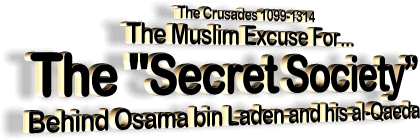
by John Daniel
from
ScarletAndTheBeast Website
To understand why this Muslim secret
society was founded at the dawn of the 20th Century, we must return
to the 11th Century thru the dawn of the 14th Century, when
Freemasonry was born during The Crusades.
First Crusade
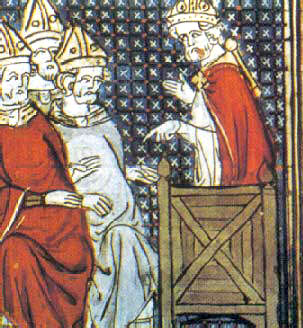
Fig. 1
Pope Urban II Salvation through violence was a revolutionary idea
when in 1095.
Pope Urban II preached it to call up the Crusaders to
take the Promised Land from the Muslims by force.
The First Crusade in 1099 A.D — The birth of Freemasonry
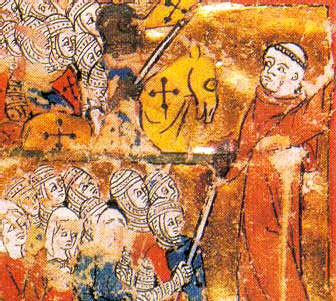
Fig. 2
Peter the Hermit Charismatic itinerant preacher, promised peasants a
better life in the Holy Land.
But few made it.

Fig. 3
First View of Jerusalem by the Crusaders
from the Hill of Emmaus, June 10, 1099.
“Jerusalem!! Jerusalem!! It is the Will
of God!!! It is the Will of God!!!

Fig. 4
First Crusaders entered Jerusalem with
Peter the Hermit and Godfrey de Bouillon.
Godfrey organized the
Priory of Sion in
1099.
Notice Christian cross on the breast of
Peter the Hermit (standing),
and Templar cross on breastplate of
Godfrey de Bouillon (mounted).
A few years later the Priory of Sion
founded the Knights Templar as its protector.
Knights Templar founded Freemasonry.

Fig. 5
Third Crusade
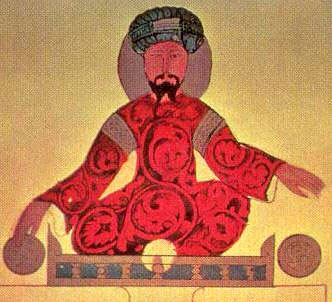
Fig. 6
Saladin (1137-1193)
His chivalry and generosity stood in sharp contrast
to many of the Christians he fought at
Jerusalem
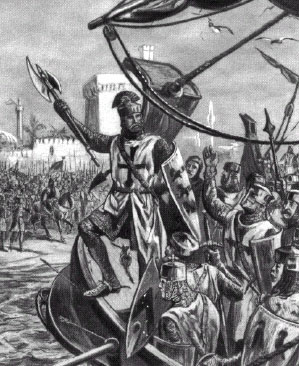
Fig. 7
Richard the Lion-Hearted (1157-1199)
Fighting Saladin in the Holy Land, this ruthless English king became
one of the Crusaders’ best-known figures.
In photo above, Richard and his
Knights Templar prepare to attack Joppa on Palestine’s coast in the
Third Crusade.
Notice the splayed Templar-cross on
Richard’s tunic.
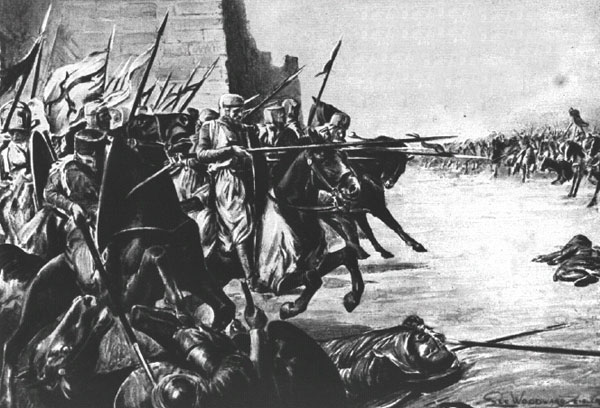
Fig. 8
Defeat of the Crusaders at Acre in 1187.
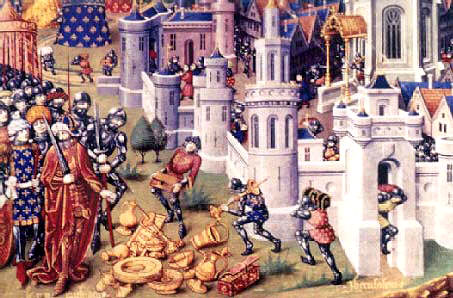
Fig. 9
Subsequent Crusaders looted Muslim
wealth in the Holy Land.
Crusaders were the
founders of what is today English and French Freemasonry
(edited excerpt below taken from
"Introduction" of Scarlet & Beast, Vol. 1)
There are two streams of Freemasonry.
-
First, the Rosicrucians, the
secret society behind the Crusaders in 1099 A.D. In 1717 the
Rosicrucians founded English Freemasonry.
-
The second stream of
Freemasonry are the Knights Templar, loosely formed by the Rosicrucians immediately following the First Crusade.
Hugh de Payens
formally organized the Templars in 1118 and became their first Grand
Master. The name “Templar” is derived from the Temple of Jerusalem.
In 1725 the Templars founded French Freemasonry.
Templars were the first religious community to yoke cross and sword.
Their initial stated purpose was to guard and guide pilgrims to the
Holy City of Jerusalem. Gradually Templar duties expanded to defend
the Holy Land against all infidels, or any force menacing Jerusalem
of their religion.
The nucleus of Templars consisted of nine men. As the order grew, de
Payens created 13 degrees within the order.57 Why he chose to stop
at “thirteen” is not known. Perhaps it represented the tribes of
Israel (eleven full tribes and the two half tribes of Joseph —
Ephraim and Manasseh). Maybe it stood for the twelve disciples and
Jesus Christ. What is significant about the number “13” is that it
identifies the Templar headquarters of our day, which nation
continues to defend the Holy Land against the Muslims.
Another symbol that identifies the
Templars is the emblem of their order. They adopted the famous
splayed red cross of
the Merovingian kings of France, placing it on
their mantles, swords, buildings, and gravestones. This symbol is
also important in tracing Templar movements to their present-day
headquarters in the “extreme west” (region of the setting sun)
according to Scripture.
After founding their order in Jerusalem in 1118, the Templars
headquartered themselves in a fortified abbey above the ruins of
Solomon’s Temple on the Temple Mount in Jerusalem — hence the name
“Templar.” Their domicile is of great significance, for somewhere
beneath it was allegedly buried the unfathomable wealth of King
Solomon.
As Templar fame increased, so did their wealth. According to
standard histories, one source of their wealth was gifts from kings
and princes grateful for their services.
As their influence grew, so too did their power and wealth.
Eventually the Templars “developed into an efficient military
organization that adopted absolute secrecy to cover all internal
activities....”
Templars also made powerful enemies, among them King Philip IV (the
Fair), who ascended the throne of France in 1268, his country near
bankruptcy. The Templars possessed both money and land in abundance,
which King Philip needed.
Failure of the Knights Templar to defend Jerusalem against the
Muslims in 1187, their extensive banking and financial interests in
both London and Paris, their rich establishments, and rumors of
heretical practices within the order, gave Philip the ammunition
needed to launch a successful campaign to destroy the order
throughout Europe. On Friday, October 13, 1307, Philip ordered the
arrest of all Knights Templar in France. Seven years later Philip
ordered then Grand Master Jacques de Molay and other dignitaries of
the Templars be burned at the stake. (Figure10).
Three centuries later, during the reign of James Stuart I, the
embryos of both Scottish and York Rites of Masonry developed in
England. At that time it was called Jacobite Masonry, in memory of
martyred Templar Grand Master Jacques de Molay. Later these rituals
became known to Masons in England and America as York Rite, and in
France and America as Scottish Rite.
Both are Templar rites.
Today,
under the flags of the U.S.A. and England, Templar Crusaders
continue to defend the Holy Land against the Muslim.

Fig. 10
Jacques de Molay, Grand Master of the
Knights Templar, burned at the stake in Paris, France on March 18,
1314.
3rd degree initiation in Blue Lodge Masonry is are enactment of the
interrogation and execution of Templar Jacques de Molay.
It is a brutal initiation, from which
comes the common saying by someone questioned about his dubious
activity,
“He gave me the ‘third degree.’”
(See Sect.1, Fig. 18 below).
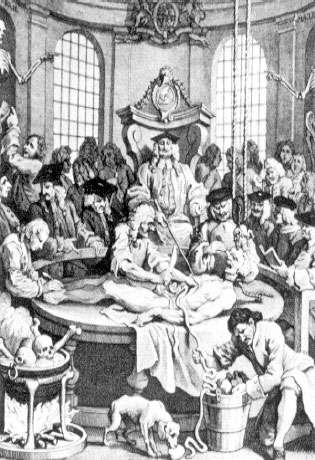
European
Freemasonry Founds Terrorist Youth Corps
(edited excerpt below taken from
Chapter 12 of Scarlet & Beast, Vol. 1)
33º Freemason Giuseppe Mazzini, after three years of intense
revolutionary training (1827-1830), concentrated on recruiting
rebellious youth to further his conspiracy of revolution. In 1831 he
was exiled to France. In 1832 he founded for his young
revolutionaries their own form of Freemasonry prefixed by the word
Young. By 1833 Young Italy had grown to 60,000 members.
In 1835, with help from Freemason Henry Palmerston, Mazzini founded
Young Europe in Switzerland. Young societies continued to organize
in new territories long after Mazzini’s death. In the new world they
were called Young America; in England, Young England; in Italy,
Young Italy; in Turkey, Young Turks. On the Continent they were
generally called Young Europe.
Young societies consisted of radical and riotous youth, many of whom
were later initiated into Templar Grand Orient lodges in their
respective countries. The Scottish Rite hierarchy directed their
activity, while the Masonic press described them as students
expressing their grievances.
All Young society members throughout Europe were taught the art of
subversion by Grand Orient Freemasonry. They were ready when called
upon to agitate, demonstrate, instigate worker strikes, hold
rallies, or spy, bomb, and assassinate. Also known as Anarchists and
Nihilists, they were reckless of every consequence, using dynamite,
the knife, or the revolver for the benevolent cause of Grand Orient
Freemasonry.
Msgr. Dillon specifically mentions that
these hoodlums (whose protection had been written into the French
Constitution), would go to Paris where they were taught the use and
manufacture of dynamite.
Although Young society members in Mazzini’s day were described as
loose-knit with no direction, they were in fact highly organized. A
few were wealthy. Some were laborers and students, others, paid
rioters. The majority had no jobs at all, yet spent money freely —
an enigma to those who had no knowledge of their Masonic backers.
After their grievances were aired by the Masonic press, public
opinion turned in the direction favorable to Grand Orient
Freemasonry.
In short, Young society members were hoodlums trained to do the
bidding of the Templar Scottish Rite hierarchy. Their duty was to
spread the secular Templar revolution throughout Europe. Mazzini was
their leader.
With this rabble, Mazzini brought Italy her Masonic Revolution.
Throughout these insurrections, Young Italy hoodlums, with no skills
or aims other than causing havoc, supported themselves by kidnapping
for ransom, robbing banks, looting or burning businesses if
protection money was not paid. This rabble became known as Mazzini’s
Association For Insurrection and Assassination.
For short the
acronym M.A.F.I.A. was used. Organized crime was born!

Fig. 11
Colonel T.E. Lawrence, mystery man of
the desert, made use of secular “Young Societies”
to assist winning freedom for Arabs from
their Muslim fundamentalist leaders.
In retaliation against the secular Young
Societies,
Muslim fundamentalist founded their own secret society
for youth,
the
Muslim Brotherhood.
T.E. Lawrence (1888-1935)
Thomas E. Lawrence, the mystery man of the desert, better known as
Lawrence of Arabia, was a soldier, Arabist, and writer. Born in
Tremadoc, Gwynedd, N. Wales, UK, he studied at Oxford, and became a
junior member of the British Museum archaeological team at
Carchemish, on the Euphrates (1911-14). In WWI he worked for Army
Intelligence in North Africa.
Lawrence was a Freemason, yet no record of his credentials are
forthcoming. He was deeply involved with the secular youth corps of
Freemasonry known as Young Societies, founded 1830 in Italy by 33º
Freemason Guiseppe Mazzini.
Wherever Lawrence journeyed in Muslim or
Arab countries, he founded many secular Young Societies. For
example, when he was assigned to Intelligence at Cairo to
investigate the Arab revolt against the Turks, he set up secular
Young Egypt, and initiated Arab male youth and trained them in
subversion against Egypt.
When the West was preparing to return the Jews to Palestine at the
close of World War One, the Arabs were unhappy. So, Lawrence
immediately went to work through that group of Arabs who were
members of Young Egypt and Young Turkey to quell the revolt.
In 1916 T.E. Lawrence joined the Arab revolt against the Turks,
entering Damascus in October 1918. He was a delegate to the Peace
Conference, and later became adviser on Arab affairs to Great
Britain’s Colonial Office (1921-1922).
He withdrew from his
legendary fame in 1922.
Excerpts from the book
What Went Wrong? - The Clash Between Islam and
Modernity in the Middle East
by Bernard Lewis
2002, Perennial
“In the mid-1860s a new movement was
launched — the Young Ottomans... It is interesting that both the
Young Ottomans and their later
successors, the Young Turks, avoided using the normal Turkish
word for ‘young’ in their nomenclature. The Young Ottomans
called themselves Yeni, which literally means ‘new.’ The Young
Turks called themselves Yonturk, simply transliterating their
French designation...
“The Young Ottomans were obviously formed on the analogy of the
Italian liberal patriot [33º Freemason] Giuseppe Mazzini’s Young
Italy and Young Europe; they agitated for a constitution and
parliament, with the inevitable result that in 1867 their
leaders went into exile, mostly to London and Paris [where both
English and French Freemasonry reside]. They returned in 1870,
and in 1876, with the help of some pressure from the European
powers, they were able to persuade the sultan to proclaim a
brand new constitution, providing for a parliament, with a
nominated senate and popularly elected chamber.
“This constitution, which owed much to the example of the
Belgian constitution and more to that of the Prussian
constitutional enactment of 1850, was far from libertarian. Even
so, it was too much. Two elections were held, the first in March
1877, the second, after a forced dissolution, in December of the
same year. The first Ottoman parliament sat for two sessions, of
about five months in all.
Nevertheless, the elected members
showed considerable vigor, and no doubt for that reason on
February 14, 1878 the sultan, exercising the imperial
prerogative, summarily dismissed parliament. It did not meet
again for 30 years.”
20th Century Almanac, World Almanac
Publ. NY.
Report on Young Turks
June 23, 1900
Turkey.
“The Young Turks, a group that
includes many students, exiles in Western Europe, and members of
the Turkish military who are determined to get rid of the
ineffectual Sultan Abdel Hamid, present a manifesto to the major
foreign embassies in Constantinople [Turkey] demanding that
these foreign powers end the Ottoman Sultan’s rule.
The Ottoman Empire has been coming apart since the early 19th
century, as subject peoples began to demand freedom. Such
minorities as the Kurds and Armenians demanded at least
tolerance, and foreign powers tried to gain territory or access
at the expense of the Empire. It will take a world war to
demolish the Ottoman Empire, after which the Young Turks will
bring Turkey into the concert of modern nations.”
Hijackers of Freemasonry
by 33º Henry C. Clausen
(1905-1993)
Past Sovereign Grand Commander of The 33º Supreme Council of the
Ancient and Accepted Scottish Rite of Freemasonry, Southern
Jurisdiction (SJ), U.S.A.
Clausen writes in the above booklet the
following account of the Young Turk revolution:
“Masons historically have been in
the forefront of movements that fired the imagination of
freedom-loving people throughout the world. Goethe, Mozart,
LaFayette were enthusiastic Masons as was the great Hungarian
hero of democracy Kossuth, who found temporary refuge in
America. Garibaldi was a 33º Scottish Rite Mason and a Grand
Master. Leaders of the Young Turkish Committee [teenage youth
corps of Turkish Freemasonry, comparable to the DeMolays in
America] that in 1908 forced Sultan Hamid “the Damned” to give
their nation a parliamentary form of government, were Masons.”
Following is a photo history of that
Turkish revolution, which was the catalyst that turned
fundamentalist Muslims into haters of the West’s freedom-loving
Masonic democracy and secularism, culminating in al-Qaeda’s 9/11
terrorist attack on America. This attack led to our war in
Afghanistan, and (as an aside) our war ill-fated with Iraq.
Pres. Bush has said, “The world will be a secular democracy,
like it or
not.”
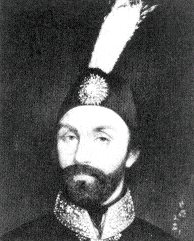
Fig. 12
Beginnings of Masonic secularization of
Turkish government.
Abdulmecid I (1823-1861)
Ottoman sultan - 1839-61
Abdulmecid I,
Ottoman sultan, who issued two major social and political
reform edicts known as the Hatt-i Serif of Gulhane (Noble Rescript
of the Rose Chamber) in 1839 and the Hatt-i Humayun (Imperial
Rescript) in 1856, heralding the new era of Tenzimat
(Reorganization) that won the respect of European Masons.
Well educated, liberal minded, and the first sultan to speak French,
Abdulmecid continued the reform program of his father, Mahmud II,
and was strongly assisted by his ministers Mustafa Resid Pasa,
Mehmed Emin Ali Pasa, and Fuad Pasa. The reform edicts were in part
directed toward winning the support of European powers. The edicts
proclaimed the equality of all citizens under the law and granted
civil and political rights to the Christian subjects. The main
purpose of the reforms, however, remained the preservation of the
Ottoman state.
The army was reorganized (1842) and conscription introduced; new
penal, commercial, and maritime codes were promulgated; and mixed
civil and criminal courts with European and Ottoman judges were
established. In 1858 a new land law confirming the rights of
ownership was introduced, and an attempt was made to establish a new
system of centralized provincial administration. The Sultan’s
educational reforms included the formation of a Ministry of
Education, military preparatory schools, and secondary schools and
the establishment of an Ottoman school in Paris (1855).
In 1849, Abdulmecid’s refusal to surrender Freemason Lajos (Joseph)
Kossuth and other Hungarian masonic revolutionary refugees to
Austria, won him the respect of the European Masons. (See Section 4
-
Fig. 24 below).

In 1853 the Ottomans were assisted by France, Great Britain, and
Sardinia in the Crimean War against Russia and were admitted as
participants in the Treaty of Paris (1856).
The European powers, however, while insisting on reforms aimed
toward the Christians and minorities in the Ottoman Empire,
obstructed the Sultan’s efforts at centralization, or at recovering
power in Bosnia and Montenegro in the Balkans.
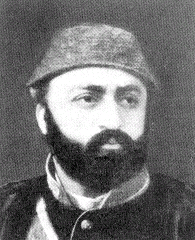
Fig. 13
Continuing the secularization of Turkish
government.
Abdulaziz (1830-1876)
Ottoman sultan — 1861-1876
Abdulaziz was a member of the Mawlawiyah (Mevlevi) order of
dervishes (Muslim mystics), yet he was an ardent admirer of the
material progress in western Europe, as had been his brother,
Abdulmecid I, who had continued the Westernizing reforms initiated
by his predecessor.
Of strong physique, Abdulaziz loved wrestling and hunting. He was
also interested in music and painting.
Between 1861 and 1871, reforms were continued under the leadership
of Abdulaziz’ able chief ministers, Fuad Pasa and Ali Pasa. New
administrative districts were set up in 1864. On French advise, a
council of state was established in 1868. Public education was
organized on the French model and a new university founded. And the
first Ottoman civil code was promulgated.
Abdulaziz cultivated good relations with France and Great Britain
and was the first Ottoman sultan to visit western Europe. However,
educated in the Ottoman tradition, he could not always accept the
adoption of Western institutions and customs. Consequently, in 1871
his reign took an anti-Western absolutist turn.
That same year Abdulaziz’ ministers, Ali and Fuad, died. France, the
Sultan’s Western model and backer, had been defeated by Germany.
Willful and headstrong, without powerful ministers to limit his
authority, Abdulaziz became the sole ruler and placed greater
emphasis on the Islamic character of the empire.
As turmoil in the Balkan provinces continued, he turned to Russia
for friendship. When insurrection in Bosnia and Herzegovina spread
to Bulgaria (1876), ill feeling mounted against Russia for its
encouragement of those rebellions.
The crop failure of 1873, the Sultan’s lavish expenditures, and the
mounting public debt had also heightened public discontent.
Consequently, Abdulaziz was deposed by his ministers on May 30,
1876.
His death a few days later was attributed to
suicide.

Fig. 14
Continuing the secularization of Turkish
government.
Abdulhamid II (1842-1918)
Ottoman sultan —1876-1909
A son of Sultan Abdulmecid I, he came to the throne at the
deposition of his mentally deranged brother, Murad.
Under his autocratic rule the reform movement of Reorganization
reached its climax. Abdulhamid’s reform adopted a policy of
pan-Islamism in opposition to Western intervention in Ottoman
affairs.
He was brought to power by a group of liberal ministers led by
Midhat Pasa. The Sultan had pledged to Midhat the position of Grand
Vizier if he would assist his rise to power. Abdulhamid fulfilled
his pledge to Midhat, who then promulgated the first Ottoman
constitution on Dec. 23, 1876. This liberal charter was, to a large
extent, adopted to ward off foreign intervention at a time when the
Turks’ savage suppression of the Bulgarian uprising in May 1876, and
Ottoman successes in Serbia and Montenegro had aroused the
indignation of Western powers and Russia.
After a disastrous war with Russia in 1877, and humiliating terms
for an armistice, Abdulhamid was convinced that little help could be
expected from the Western Powers without their intrusion into
Ottoman affairs. He then dismissed the Parliament, which had met in
March 1877, and suspended the constitution in February 1878. For the
next forty years he ruled from his seclusion at Yildiz Palace in
Istanbul [modern Turkey], assisted by a system of secret police, an
expanded telegraph network, and severe censorship.
Discontent with Abdulhamid’s despotic rule and resentment against
European intervention in the Balkans, however, led to the military
revolution of the Young Turks in 1908.
After a short-lived
reactionary uprising in April 1909, Abdulhamid was deposed, and his
brother was proclaimed sultan Mehmed V.
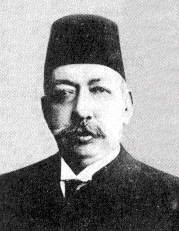
Fig. 15
Continuing the secularization of Turkish
government.
Mehmed V (1844-1918)
Ottoman sultan — 1909-1918
His reign was marked by the absolute rule of the Committee of Union
and Progress, and by Turkey’s defeat in World War I.
After having lived in seclusion most of his life, Mehmed Resad
became sultan after his brother Abdulhamid II was forced to
abdicate. A kind and gentle man, educated in traditional Islamic
subjects and Persian literature, he showed a keen interest in
Ottoman and Islamic history. Nevertheless, he lacked the ability to
govern.
Attempting to rule as a constitutional monarch, he surrendered all
authority to the Committee of Union and Progress, the
liberal-nationalist organization of the Young Turk movement.
On the advice of the committee, the Sultan went on a goodwill tour
of Thrace and Albania in 1911. In the two Balkan Wars during
1912-13, however, the Ottomans lost almost all their European
possessions, and in the war with Italy in 1911-1912, Tripoli was
lost.
Although Mehmed was opposed, the Ottoman Empire entered World War
One on the side of Germany and Austria-Hungary, and as caliph, he
declared holy war and invited all Muslims, especially those under
the rule of the Allies, to rally to the support of Ottomans.
By the time of Mehed’s death, most of the empire had fallen to the
Allies, and six months later Istanbul [Turkey] was under military
occupation.
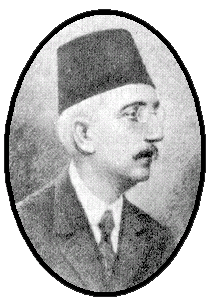
Fig. 16
Continuing the secularization of Turkish
government.
Mehmed VI (1861-1926)
Ottoman sultan — 1918-1922
The last sultan of the Ottoman Empire, whose forced abdication and
exile to San Remo, Italy in 1922 prepared the way for the emergence
within a year of the Turkish Republic under the leadership of
Mustafa Kemal Ataturk.
Clever and perceptive, Mehmed VI became sultan July 4, 1918, and
attempted to follow the example of his elder brother Abdulhamid II
by taking over personal control of the government.
After the Armistice of Mudros on Oct. 30, 1918, and the
establishment of the Allied military administration in Istanbul on
Dec. 8, 1918, the nationalist-liberal Committee of Union and
Progress had collapsed, and its leaders had fled abroad. The Sultan,
opposed to all nationalist ideologies and anxious to perpetuate the
Ottoman dynasty, acceded to the demands of the Allies. On December
21 he dissolved parliament and undertook to crush the nationalists.
The nationalists, however, who were organizing in Anatolia under the
leadership of Mustafa Kemal, sought the Sultan’s support in their
struggle for territorial integrity and national independence. After
negotiations, the Sultan agreed to elections, which were held late
in 1919. The nationalists won a majority in the new parliament. The
Allies, alarmed at the prospect of Turkish unity, extended the
occupied area in Istanbul and arrested and exiled the nationalists.
The Sultan dissolved the parliament on
April 11, 1920. The nationalists set up a provisional government in
Ankara. Mehmed’s signing of the Treaty of Sevres on Aug. 10, 1920,
however, reduced the empire to little but Turkey itself and served
to strengthen the nationalist cause. After the defeat of the Greeks,
the nationalists were in solid control of Turkey. The Grand National
Assembly on Nov. 1, 1922, abolished the sultanate. Sixteen days
later Mehmed VI boarded a British warship and fled to Malta.
His
later attempts to install himself as caliph in the Hejaz failed.

Fig. 17A
Kemal Ataturk used “Young Turks,”
Freemasonry’s secular youth organization, to depose the Sultan and
win freedom for the Turks.
On March 24, 1923, TIME magazine wrote,
“Mustapha Kemal Pasha... has lifted the
people out of the slough of servile submission to alien authority,
brought them to... independence of
thought and action.”
Kemal Ataturk (1881-1938)
Emergence of Turkey as a modern nation in this century was due in
large part to the implacable energy and vision of one man, born
Mustafa Kemal, who as leader of his country took the not unwarranted
name Ataturk, meaning “Father of the Turks.” He was instrumental in
the liberal Young Turk (earlier called Young Ottoman) revolution of
1908, which deposed the sultan. Young Societies in Europe were
founded in 1830-1860 by 33º Freemason Giuseppe Mazzini, head of
Italian Freemasonry.
Lawrence of Arabia followed by planting
Young Societies throughout the Near East, using young secular
Muslims
to topple the Ottoman Empire.
Despite quarrels with the new government about its German
allegiance, Ataturk led the Turkish forces to victory over the
Allies at Gallipoli during World War I. After the war, when the
Allies reinstated the sultanate, Ataturk (with his Young Turks),
mounted a resistance movement that expelled the Greek invasion in
1920 and abolished the sultanate again in 1922. Ataturk, when
becoming President of the New Turkish Republic in 1923, changed
Turkey into a modern secular country in the Western mold by ruthless
force of will.
As violent and vindictive as his reforms often were
(particularly those directed at Islam), his nation mourned his
passing in 1938.
Howard Chua-Eoan writes in TIME’s
80 Days That Changed The World
“Ataturk Commands His People: Westward,
Ho!” (2003):
General Mustafa Kemal, who had
repelled the British at Gallipoli in 1915 and had just recently
done the same to invading Greeks, now planned a civil takeover
of his own country. Just hours before he did it, Kemal was
telling a journalist that popular Islam had become a morass of
superstitions that would destroy those who professed it. He
declared, “We will save them,” according to biographer Andrew
Mango. A 101-gun salute greeted the announcement: Turkey had
ceased to be an Islamic empire.
It was a republic, and its leader,
Kemal, became President — not Sultan, not Caliph, the titles
that Ottoman monarchs paraded for 600 years — the first as
despots who once made Europe cower, the second as “Commanders of
the Faithful,” leaders of Sunni Muslims everywhere. Soon Western
clothing was enforced and Roman letters replaced Arabic-based
script. The man who would adopt the name Ataturk (“father of the
Turks”) inaugurated an era in which nationalism, not Islam,
would be seen as the solution to the trouble of Muslim peoples.
But by the 1980s, a reaction would
set in, and the cause of the caliphate eventually would be taken
up by, among others, Osama bin Laden.
Eighty years after Mustafa Kemal Ataturk
revolutionized his nation and turned its face toward Europe, Turkey
remains an outsider in two worlds, held at arm’s length by both its
European and Arab neighbors.
Long a member of NATO, Ataturk’s nation
smarted as the European Union accepted a gaggle of former Warsaw
Pact nations but put Turkey on hold.
On Istanbul’s streets,
conservative Muslims pass artsy young women with their hair
uncovered. In its governing councils, democracy and its freedoms are
hailed as shining ideals, but open debate is discouraged. In some
ways, the nation is not so far removed from the days of Ataturk,
dictator-of democracy who issued fiats banning Arab garb — in the
name of freedom.
Turkey’s ruling elites followed
Ataturk’s resolute secularism for decades, but lately some Turks
have called for a society more in tune with the nation’s Islamic
heritage. In the November 2002 elections, voters threw out the
longtime ruling party in favor of a pro-Islamic party headed by
former Istanbul Mayor Recep Tayyip Erdogan.
Turkey soon found itself
caught between its twin beacons:
U.S. President George W. Bush wanted
Turkey to allow U.S. troops to invade Iraq from Turkish soil,
but in a major blow to U.S. plans, the new Parliament vetoed the
plan. With the U.S. looking forward to a post-Saddam Middle
East, its diplomats will confront a Turkey in evolution, as the
most democratic nation in the Islamic world turns its face
toward Mecca again.
32º Mehmet Talaat Pasha
(1872-1921)
Turkish political leader. After Turkish revolution of 1908, he
became leader of Young Turks. He later became minister of interior,
postmaster general and eventually succeeded Said Halim Pasha as
grand vizier of Turkey (1917). Was forced into retirement Oct. 1918.
Served as Grand Master of the Grand Orient Masonic Lodge of Turkey.
Left Turkey in 1919. Two years later was assassinated in Berlin by
an Armenian student.
33º Selim Sarper
(1899-?)
Permanent representative of Turkey to UN beginning in 1947 with rank
of ambassador. Educated at U. of Ankara. Officer of foreign service
of Turkey since 1927. Served in Odessa, Moscow, Berlin, Bucharest.
Press officer to prime minister, 1940-44. Ambassador to Moscow,
194146, and Rome, 1946-47. 33º AASR Mason. Appeared at numerous
Masonic functions in NYC.
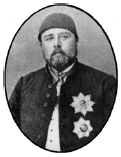 33º
Khedive Ismail Pasha
(1830-1895) 33º
Khedive Ismail Pasha
(1830-1895)
First Grand Master of the Grand Lodge of Egypt and khedive of Egypt
(1863-1879), who, in 1879 presented the famous “Cleopatra’s Needle”
to the United States. It was originally erected in Heliopolis,
Egypt, about 1500 B.C. Weighing 200 tons, its removal and
re-erection was quite a problem. It was shipped under the direction
of Comdr. H. H. Gorrige, a Mason, and on Oct. 9, 1880 the foundation
stone of the monument’s base was laid with Masonic ceremonies.
Muslim Brotherhood
An organization founded in Egypt in 1928
by Hasan al-Banna (1906-1949), calling for a return to rigid
orthodoxy, the overthrow of secular governments, and a restoration
of the theocratic state.
— Random House Dictionary; — see Fig. 17B
below
“Turkey”
Mackey’s Revised
Encyclopedia of Freemasonry
Vol. 2, p. 1061 — 5th printing, 1950
“A writer in the Freemasons
Quarterly Review (1844, page 21), says that there was a Masonic
meeting in Constantinople, at which some Turks were initiated,
but that the government prohibited...future meetings....
“Many and various authorities have founded Lodges in Turkey.
Mention of Lodges at Smyrna and Aleppo occurred in a London
newspaper as early as 1738. Oriental Lodge under the Grand Lodge
of England has been active since 1856 at Constantinople.
“A Grand Lodge of Turkey formed by Ionic, Anatolia, and
Benzenzia Lodges was declared illegal in 1859 by the Grand Lodge
of England.
“A District Grand Lodge was establish in 1861 with Sir Henry Bulwer, British Ambassador, as District Grand Master. A Supreme
Council was opened in 1869 and a Grand Orient of Turkey in 1908.
“Since 1894 the Grand Lodge of Hamburg has had a Lodge working
in German, Die Leuchte am goldenen Horn, meaning Light at the
Golden Horn, these last two words referring to the
crescent-shaped strait, the Bosporus, on which Constantinople is
situated. The Grand Orient of Italy has three, the Grand Orient
of France one, all at Constantinople.
“The Grand Orient of France has two Lodges at Smyrna, Homere
from 1909 and Meles from 1913; Bakai from 1905 at Jaffa, and
Moriah Lodge at Jerusalem since 1913. The Grand Orient has also
had a Lodge at Beyrouth in Syria, Le Liban from 1868; and at
Zahle, also in Syria, Etoele du Liban, meaning in French Star of
the Liban, since 1913. The Grand Orient of Italy has Lodges at
Adana and Angora, two at Smyrna, one at Syrian Tripoli, and
another at Rodi.
“In these Lodges many native Mohammedans have been initiated.
The Turks, however, have always had secret societies of their
own, which has led some writers to suppose, erroneously, that
Freemasonry existed long before the date of its actual
introduction. Thus, the Begtaschi form a secret society in
Turkey, numbering many thousands of Mussulmans in its ranks, and
none but a true Moslem can be admitted to the Brotherhood. It is
a religious Order, and was founded in the year 1328 by the Hadji
Begtasch, a famous dervish, from whom it derives its name.
The Begtaschi have certain signs and
passwords by which they are enabled to recognize the “true
Brethren,” and by which they are protected from vagabond
impostors. A writer in Notes and Queries says, in summer of
1855, and English merchant captain, while walking through the
streets of a Turkish quarter of Constantinople, encountered a
Turk, who made use of various signs of Freemasonry, some of
which (the captain being a Mason), he understood and others he
did not.
It is, however, probable in this
instance, considering the date, that the Turk was really a
Freemason, and possessed some higher Degrees, which had not been
attained by the English Captain. There is also another equally
celebrated Order in Turkey, the Melwi, who have secret modes of
recognition.”
“Young Turks and Masonry”
Mackey’s Revised Encyclopedia of
Freemasonry
Vol. 3, p. 1393 — 1950
“Bro. Ernest Jackh, a member of the
faculty of Columbia University, New York, began in 1908 his
extraordinary career as political and diplomatic expert on
Turkey and the Balkans. He saw the fall of the Ottoman Empire,
was in continuous relationship with Enver Pasha, Mustapha Kemal
[Ataturk], etc., during the ten years of the Young Turks
movement, and had a part in the founding of the Turkish Republic
under Kemal.
Regularly constituted Masonic Lodges
take no part in political and military enterprises, but
oftentimes for that reason are in the center of them because
within their tiled doors men from every side and opinion can
meet and become acquainted without embarrassment or political
commitments.
On page 92 of...The Rising
Crescent (Farrar & Rinehart; New York; 1944) Bro. Jackh
writes:
Besides vatan
(fatherland) there was another word in everybody’s mouth and
in every newspaper: hurriet, Liberty. At that time (1908) I
frequently attended Masonic Lodge meetings of the Young
Turks. Among my Brother Masons I would meet Moslems and
Christians, Turks, Arabs, Armenians, Greeks, Bulgarians,
Jews, and Doenmés (Jewish Moslems) — all with the common
headdress, the fez, the mark of citizenship in the Ottoman
Empire.
When liberty was discussed it
would be applied to all the national groups within the
supranational empire, all now liberated from the Hamidian
regime of absolutism and palace intrigue. Under the
constitution renewed by the Young Turks the non-Moslem
nationalities had their full share of “liberty, equality,
and fraternity.”
In the Bill of Rights included in the
Constitution of the Republic of Turkey, Freemasonry is
explicitly provided for, not by name, but by means of the
words italicized in the sentence:
“No one shall be molested on
account of his religion, sect, his ritual or his
philosophic convictions."
This was written in 1944.
Today Turkish
attitudes toward secular freedom and the Freemasonry that brought it
about, is despised by the Muslim world, as evidenced by the news
clipping on the next page.
Payback time
Muslims know that western Freemasonry is
behind democratizing their world. Prior to World War I, when Turkey
was in the throws of revolution, Muslims lost the Ottoman Empire to
a Masonic Turkish democracy. In retaliation Muslim terrorists
infiltrated Young Serbia, the youth order of European Freemasonry,
and assassinated Archduke Ferdinand in 1913, triggering World War
One.
Western democracies have not learned
their lesson, for once again the West is forcing democracy on Muslim
nations, with democrats hidden within Masonic Lodges in their lands.
Beginning with Afghanistan, then Iraq, Muslims know that following a
democracy comes secularization. And behind both is Western
Freemasonry. Hence, we see increased attacks on Masonic Lodges by
Muslims. But the press will report few of them.
Below is one back page report in
Istanbul.
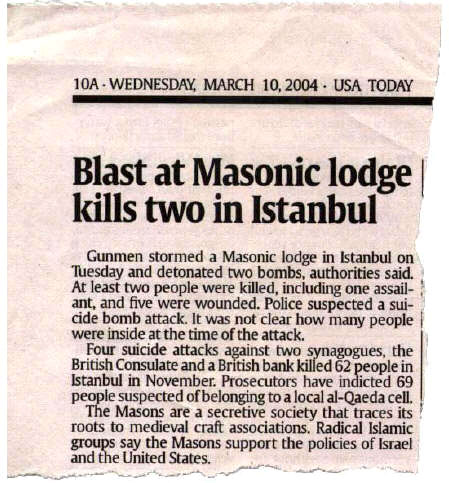
Freemasonry’s
Young Societies vis-a-vis Muslim Brotherhood’s Al-Qaeda
As are the Scottish and York Rites of Freemasonry both secret
societies, al-Qaeda is likewise a secret society. Like Freemasonry,
al-Qaeda denies its own existence in order to remain in the shadows.
In this regard al-Qaeda is set up identically to
Adam Weishaupt’s
Illuminati.
In 1830 Illuminated Freemasonry, under the leadership of 33º
Freemason Giuseppe (Joseph) Mazzini, organized Freemasonry’s
terrorist arm (Young Societies), consisting of 16 to 21-year-old
male youth. Their assignment? Secularize both Christian and Muslim
countries through terror and revolution.
Within their respective host nations, Young Societies became known
as Young Italy, Young Germany, Young Serbia, Young Russia, Young
America, Young Egypt, Young Turks, etc.
In 1908 the Young Turks compelled the unwilling sultan of the
Ottoman Empire to restore the constitution of 1876. These early
constitutional reforms were obviously the result of European Masonic
influence and example, along with the desire to compete with Europe
on equal terms. They were also gestures of propitiation — to qualify
for loans and other benefits, while at the same time ward off
intervention and occupation by European powers.
At that same time the Armenian leadership cooperated with the Young
Turk committees in overthrowing the despotic rule of Sultan
Abdulhamid II, and in accomplishing the Young Turk revolution of
1908. In 1912, Young Serbia was behind the terrorist attacks that
triggered a series of Balkan Wars. Balkan allies, Bulgaria, Serbia
and Greece, made substantial territorial gains at Ottoman expense,
and Albania was added to the roster of independent states.
The final attack, which triggered World
War I, was by Young Serbian Freemasons, who assassinated Archduke
Ferdinand, heir to the Austria-Hungarian throne. (see Section 6
-
Figs. 4-8 below).
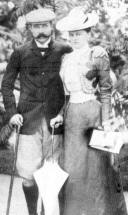 
 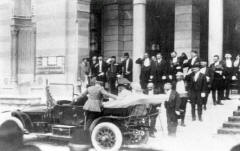 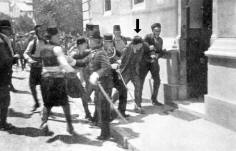
The Young Turks
blundered into World War One on the side of the Central Powers and
found themselves involved in a death struggle, in which their
traditional Masonic friends of Western Europe became their enemies.
Eleven years following World War One the Muslim Brotherhood was
founded in Egypt as an Islamic fundamentalist counteraction to
western Freemasonry’s secular youth corps of Young Societies. The
Muslim Brotherhood called for a return to rigid Muslim orthodoxy,
the overthrow of secular governments, and a restoration of the
theocratic Muslim state.
In 1954 the
Muslim Brotherhood made an attempt on the life of Prime
Minister Gamal Abdel Nasser of Egypt. Nasser shut down the
Brotherhood by driving it into exile in Syria.

Fig. 17B
Hasan al-Banna (1906-1949)
founder of The Muslim Brotherhood in
1928
June 25, 1980
The Muslim Brotherhood tried to
assassinate Hafiz al-Asad of Syria — an Alawite Muslim. An angered Asad made a decision to destroy the Brotherhood. The next morning
two of Asad’s elite guard units (the Defense Companies) loaded into
choppers, then flew east to Palmyra’s notorious military prison
where Muslim Brothers were being held. Waiting guards threw open the
doors. The Defense Companies stormed in, moving from cell to cell,
executing prisoners. The Brothers had only time enough to yell, “God
[Allah] is great!”
Although 500 Brothers died that day, the Brotherhood
was not intimidated. February 1982 the Brotherhood seized the city
of Hama on the Orontes River, Syria’s fourth largest city, with
roots going back to the Bronze Age. When they started cutting
throats of Alawite Muslim officials and their families, Asad acted.
He called in the Defense Companies again and ordered, “Level the
city.”
Two days of continuous shelling left
Hama a smoldering pile of rubble. An estimated 20,000 were killed,
including most of the Muslim Brotherhood. Hafiz al-Asad was not
happy to go down in history as the butcher of Hama, or the man who
destroyed a world-class historic city, but it was either that or run
for it, along with a million other Alawites. The Muslim Brotherhood
would never again pose a serious threat to Asad.
Instead, it came to
terms with Syria, formed “Hamas” (named after the city of Hama), and
based out of Syria, directed its terror against Israel.
-
On October 6, 1981, the world first witnessed the bloody
consequences of the Muslim Brotherhood when it assassinated
Anwar
Sadat.
-
Again in 1993 the Brotherhood tried to kill the interior
minister and later the prime minister of Egypt.
-
In 1995 they tried
to kill Hosni Mubarak while he was visiting Ethiopia.
-
Two years
later, the Brotherhood attacked the temple at Luxor, killing
fifty-eight foreign tourists and four Egyptians.
-
Muslim Brotherhood
attacked once more on 9/11/2001, in New York City
and suburban Washington, DC.
The press, however, kept calling the
attackers “al-Qaeda,” thanks to Osama’s relentless publicity
machine.
Founder of al-Qaeda
Dr. Abdullah Azzam, born in 1941 to a Muslim family in northern
Palestine, was the Palestinian-Jordanian ideologue who
conceptualized al-Qaeda in 1987. As a young man, Azzam joined the
Egyptian Muslim Brotherhood and later became a stalwart of its
Jordanian chapter.
Like Freemasonry, the Muslim Brotherhood’s
multinational members are designated as “brothers,” operating in
groups called cells, as did illuminated Freemasonry from its
beginning, and continues the same today.
Each cell is
self-contained. Hence, any cell plucked would not affect the whole.
Osama bin Laden
Osama was taught Islamic studies by Muhammad Qutb, whose brother was
Sayyid Qutb, the ideologue of the Muslim Brotherhood. When Osama
arrived in Afghanistan, he fell under the influence of Dr. Abdullah Azzam, who mentored him. Both men together ran the
Afghan Service
Bureau through a network of offices, including thirty in United
States cities, which disseminated their propaganda, raised funds,
and recruited new members.
On November 24, 1989, in Peshawar, Dr. Azzam was driving to a local
mosque with his two sons and one of their friends when his car
evaporated in a giant explosion. No one was ever charged with
Azzam’s death. Early reports said he had had the misfortune of
running into one of the region’s many land mines. However, the ISI,
whose file on Azzam was the largest of any intelligence agency,
concluded that al-Zawahiri’s Islamic Jihad carried out the murder as
a favor to Osama bin Laden.
The hierarchy in al-Qaeda is formed identical to Freemasonry’s
Illuminati capstone atop the pyramid. And as Freemasonry’s pyramid
base consists of student “cells,” so too does the Al Qaeda al-Sulbah,
which means “The Solid Base” of the pyramid. And like Freemasonry,
al-Qaeda’s cellular network makes it resistant to intelligence
service penetration.
The Taliban, which means students, is identical in structure to the
original student membership of the Illuminati, and later to
Freemasonry’s Young Societies. And like cells of students within
the Illuminati, represented by the bricks on the base of the Illuminati
pyramid (as seen on the back of the U.S.A. $1 bill), al Qaeda
likewise set up student cells for its base of operation. And as did
the Illuminati build a worldwide network of secret societies, so too
did al Qaeda’s leadership build a secret organization that now
covers the entire world, including many cells in Mosques in the
U.S.A.
Al-Qaeda membership was and continues to be recruited from the
Muslim Brotherhood, which made certain Islamists receptive to
Osama’s message. Muhammad Atta, the al-Qaeda team leader of
September 11, for example, was first a member of the Egyptian Muslim
Brotherhood. And while the bloodthirsty Brotherhood only spoke of
martyrdom, al-Qaeda actually practiced it on a worldwide scale.
Sources:
-
The Middle East, A
Brief History of the Last 2000 Years, by Bernard Lewis,
Simon & Schuster; A Touchstone Book, 1997
-
Inside Al Qaeda, by Rohan
Gunaratna, Berkley Books, NY, 2003
-
Sleeping with the Devil,
How Washington Sold Our Soul for Saudi Crude, by
Robert Baer, Crown Publishers, NY, 2003
-
Why America Slept, The
Failure to prevent 9/11, by Gerald Posner, Random House, NY,
2003
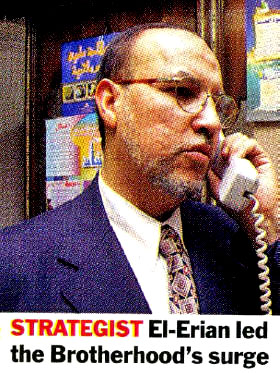
Fig. 18
TIME Magazine — December 19, 2005
The Muslim Brother hood becomes
political through the ballot box.
Posters on the wall herald the march of
Islam, but tonight the Cairo headquarters of the Muslim Brotherhood
is a different kind of war room.
Essam El-Erian, chief political
strategist for the banned but officially tolerated fundamentalist
group in Egypt,
performs evening prayers with a dozen other
officials and then starts working the phones...
checking on the
results of the final round of the parliamentary elections held last
week in Egypt.
Early returns look promising.
Hitler, Muslims, and
World War II’s anti-Semitism
From Scarlet and the Beast, Vol.
1, 3rd ed. Chapter 26
Thule Society - Its Founder and
Membership
“Although
the Thule Society was an
offshoot of the Golden Dawn, its official founder and head was
Baron Rudolf von Sebottendorff (1875-1945), a Knight of the
Masonic Order of Constantine (Turkish Freemasonry). Sebottendorff was the leader of the ‘Turkish Crescent,’ which
fought in the Balkan War of 1912-1913 against the Grand Orient
revolutionists backed by Serbia. In the ranks of the
revolutionists were Jews, and consequently during the conflict
Sebottendorff [a Moslem] became violently anti-Semitic.
In 1913 he returned to Germany
fortified with a vast knowledge of the occult and substantial
funds from an unknown source. During the next four years he made
extensive contacts with the leading members of numerous
international occult groups that were rapidly proliferating in
Germany at that time, focusing his Contacts on the Order of the
Golden Dawn. Late in 1917 Sebottendorff was in Munich to begin
organizing the Thule Society.
With assistance from Golden Dawn
members, on August 17, 1918, the Thule Society was officially
founded. Sebottendorff elevated himself to Grand Master, then
recruited from among the German noble families and aristocracy
to use the Society as their counterrevolutionary headquarters.
To his later discredit and ultimate downfall, Sebottendorff
published a list of the Thule Society’s membership.
“Sebottendorff claimed he had been sent to Germany by the
Ascended Masters of Islam, who,
‘had entrusted him with the
mission of illuminating Germany through the revelation of the
secrets of advanced magic and initiation into ancient oriental
mysteries.’
One of the mysteries Sebottendorff imparted to the
Thule membership was the so-called revelation that the Jews were
behind world revolution and therefore must be annihilated.”
Anti-Semitism and the Thule Society
Another Thule Society member who added strength to Sebottendorff’s
anti-Semitic accusations was Alfred Rosenberg (1893-1946). Rosenberg
grew up as a Baltic German in Revel, Estonia, and spoke perfect
German and Russian. He studied architecture at Moscow University and
graduated there in 1917. He witnessed Kerensky’s revolution in
February and saw it destroyed in October by Lenin, a half-Jew, and
Trotsky, a full-blooded Jew. In the spring of 1918, he read the
newspaper headlines which announced the assassination of the Czar
and his royal household at the hands of a Jew.
Then he watched as 82 percent of the new
Communist bureaucracy was staffed by Jews.
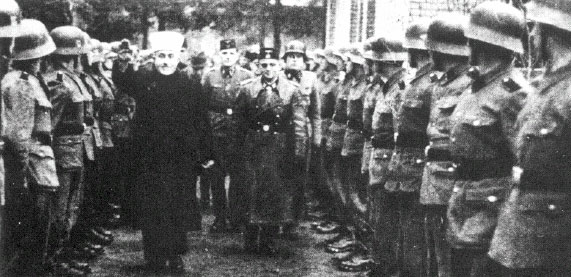
Fig. 19
Mufti of Jerusalem
Mufti: Muslim
official who interprets law of Koran & tradition.
He was a Muslim fundamentalist opposed
to secular societies.
Mufti of Jerusalem inspects Muslim unit of German army — January
1944.
Haj Amin al-Husseini, the Mufti of Jerusalem, had been blackened as
a suave Muslim religious leader who encouraged terrorism and
fascism. He was particularly influential in the fundamentalist
Muslim Brotherhood headquartered in Egypt. Murder of political
opponents and intimidation of the uncommitted became the normal
tools of his trade in the 1930s.
Following Hitler’s coming to power in Germany in 1933, a brutal and
systematic persecution of Jews spread across central Europe.
Thousands fled and sought sanctuary in Palestine. In 1935 alone some
60,000 Jewish immigrants arrived. Arabs saw this influx as
confirmation of their fear that the British and the Zionists were
conspiring to reduce them to a minority in their own land.
Much as the Colonial service officers on the spot tried to be fair
to the Arabs, the pull of Zionist influence in London and Washington
constantly overrode them.
Finally, in 1939 the white paper offered the Arabs practically all
they asked. Had the Mufti and Muslim Brotherhood around him been
politically skilful they would have seized the moment.
But the Mufti
insisted on all or nothing — and got nothing.
Britain, in its role as patron of Arab interests, had encouraged the
creation in 1944-45 of the Arab League, to coordinate the policies
of the independent Arab states. After WWII the Mufti was living in
Cairo, Egypt.
However, the Mufti found the Arab League less helpful
than he had hoped.
End of Empire, by Brian Lapping, St. Martin’s
Press, NY., 1985, pp. 113, 140, 246.
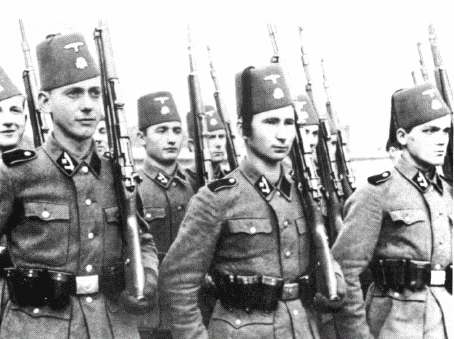
Fig. 20
Bosnia and Herzegovina Muslim volunteers in the Nazi Army.
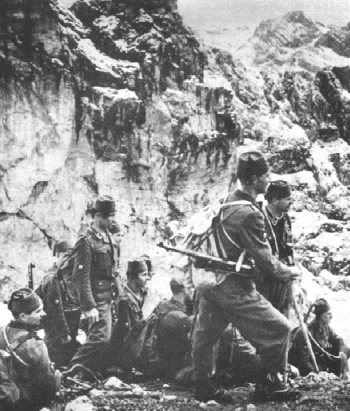
Fig. 21
Croatian Muslim volunteers in the Nazi Army.
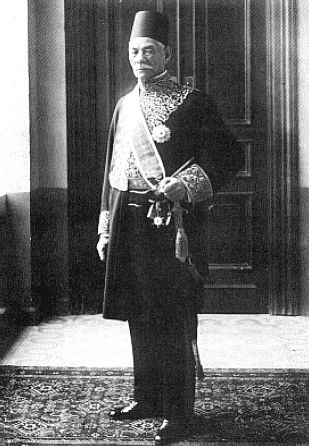
Fig. 22
Egyptian Freemasonry used to throw off
the yoke of colonialism.
Pasha Saad Zaghlul (1860-1927)
Premier of Egypt in 1924. A lawyer and statesman, he was minister of
public instruction in 1906, and later, minister of justice.
After the close of WWI, he became head of the Nationalist Party,
which advocated and demanded the breaking of ties binding Egypt to
Great Britain. He failed in his attempt to conclude the negotiation
with British Prime Minister MacDonald. He was deported to Malta in
1919 and then to Ceylon, returning to Egypt in 1921.
One of the two
Egyptian Grand Lodges to which he belonged ordered 7 weeks of
mourning after his death.

Fig. 23
King Farouk I — Last reigning king of
Egypt (1936-1952) and a Freemason,
lost his secular throne to a
fundamentalist secret society, the Muslim Brotherhood,
counterpart to Masonry’s secular Young
Societies.
King Farouk I (1920-1965)
Last reigning king of Egypt (1936-52), born in Cairo, the son of
Faud I. He was educated in England and studied at the Royal Military
Academy, Woolwich. After WWII he turned increasingly to a life of
pleasure. At this time the Allies handed the Jews Palestine.
Although Britain did not support the partition of Palestine, nor
openly back the Jews in 1947, Egyptians were familiar with British
deception, and heaped blame on them.
The Mufti of Jerusalem was living in Cairo at that time and helped
to persuade Egyptians that the handing of Palestine to the Jews was
an act of British perfidy. The Mufti was particularly influential in
the fundamentalist Muslim Brotherhood, a counterpart secret society
to secular Young Egypt. The growth of the Muslim Brotherhood had
been a problem to secular Farouk for many years. Its members wanted
Egypt to be an austere Islamic state. The Partition of Palestine
boosted the popularity of the Muslim Brotherhood to new heights.
Muslim countries united to take back Palestine, but were soundly
defeated.
The defeat of Egypt by Israel and
continuing British occupation led to increasing unrest, and General
Neguib’s coup (1952) forced Farouk’s abdication and exile.
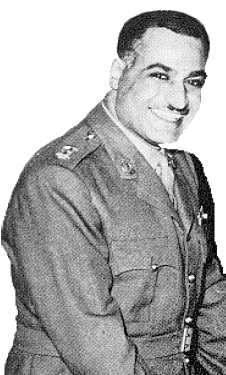
Fig. 24
Nasser used Freemasony’s secular youth
organization to win freedom for the Egyptians.
Gamal Abdel Nasser
(1918-1970)
Egyptian statesman, prime minister (1954-1956), and president
(1956-1970), born in Alexandria. Nasser was only a babe when
Freemason Lawrence of Arabia was using Young Societies (youth corps
of Freemasonry founded in the Middle East a century earlier by 33º
Freemason Joseph Mazzini) to throw off the yoke of Muslim
fundamentalist mid-Eastern tyranny.
As a young man in Egypt, Nasser joined Young Egypt, which organized
demonstrations against British control of Egypt. As an army officer,
he became dissatisfied with the corruption of the Farouk regime and
was involved in the military coup of 1952. He assumed the
premiership in 1954, and then presidential powers.
Thereafter, he developed the Nation’s military strength and the
economy, began building the Aswan Dam, and nationalized the Suez
Canal (which led to an abortive invasion by Britain, France, and
Israel).
The respect he commanded among Arabs helped Nasser promote pan-Arab
movements, including the United Arab Republic formed by Syria in
1958 with Nasser as president. (Syria withdrew in 1961).
A fervent anti-Zionist, Nasser attacked Israel in 1967. After the
resulting quick defeat by Israel, he resigned, but was immediately
returned to office by popular acclaim.
His last years were spent rebuilding his military forces with Soviet
support, and seeking inroads to negotiations with Israel. He died in
1970, having brought increased respect and dignity to the Arab
world.

Fig. 25
Cover of TIME Magazine, 11/25/02
It should come as no surprise that
al-Qaeda members are recruited from this fundamentalist Muslim youth
order. TIME Magazine, “Architect of Terror” 3/10/03, p. 24, confirms
that the recently captured Khalid Shaikh Mohammed, the architect of
9/11, who became the “third man” upon the death of Mohammed Atef,
“was committed to Islam from an
early age. The son of a devout Pakistani living in Kuwait, he
joined the Egypt-based Muslim Brotherhood as a young man.”
On March 20, 2003, as our military was
advancing on Baghdad, FOX NEWS reported:
“The riots against the war by young
Muslims in Yemen were sponsored and promoted by the Muslim
Brotherhood.”
The Muslim Brotherhood founded and
organized the Islamic fundamentalist secret society (al-Qaeda) in
the same format as Western Freemasonry’s Young Societies.

Fig. 26
Bagdad’s sorcery and witchcraft.
Saddam’s wizard tells of a leader obsessed with sorcery.
Twenty-four million people in Iraq use
some sort of magic.
AP Photo, August 15, 2003.
Sayed Sadoun Hamid el-Moussaoui al-Refai, 56, meditates in his magic
room recently in Baghdad, Iraq. Al-Refai uses his 7-year-old son as a
medium to find things, or people that are lost.
The wrinkled old man sprays perfume around the sparse, dingy room,
then holds out his hands and feet and instructs one of his visitors
to tie him up, knot the cloth three times and blow on it. The lights
die and small red flashes go off beneath the black cloak that covers
a bowl of magic powders and water.
In the darkness, visitors feel pokes and
jabs and things fluttering over their heads.
“Birds,” the wizard says. Water
splashes from the bowl. The genies arrive, and the questions
begin.
“Will Saddam be found?”
A genie answers in the old man’s voice: “Yes.”
“Dead or alive?”
“Dead.”
“Where is he?”
“In Dhuluaiyah,” a village 55 miles north of Baghdad.
Thousands of magicians, fortune-tellers
and faith healers make up a huge world of Iraqi spirituality that
thrives despite being considered by many Muslims as sinful. But this
man is different. He was Saddam’s own sorcerer, and, therefore, his
visions of the dictator’s demise carry special weight for Iraqis.
According to the magician and several
others interviewed in Baghdad, Saddam was a firm believer in
magic.
 
Figure 27
So much for the accuracy of Saddam’s
wizard.
The “Butcher of Bagdad” was captured alive Dec., 2003.
These soldiers had been scouring the
area for months in the belief that he would stay close to home,
where loyalty among those who most
benefited from his rule still ran deep.
U.S. intelligence sources tell Time
Magazine that over the past month they were getting better leads.
CAPTURED ALIVE
It was a team of 600 soldiers from the
4th Infantry Division and U.S. special forces that acted on the tip
that Saddam was hiding in a little town called al-Dawr, (15 miles
from his hometown of Tikrit), not in Dhuluaiyah, 55 miles north of
Baghdad, as Saddam’s sorcerer had predicted. Saddam’s sorcerer had
predicted
he would be found dead!
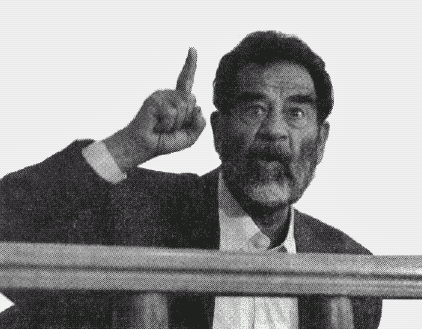
Fig. 28
Saddam Hussein’s first day in court —
frightened, yet defiant.
New York Times News Service (July 2,
2004)
BAGHDAD, Iraq — With the image of Saddam Hussein in the dock
flickering on the television screen before him, Sami Hassan
shook his head in disbelief, struggling against the tears that
came down his cheeks.
“This is a theater,” said Hassan, a 47-year-old ex-member of the
Baath Party, mimicking the words of his former boss on the day
that he appeared in court.
Hassan’s reaction was part of the outpouring of emotion that
coursed through the Iraqi capital Thursday. The images of a
once-omnipotent dictator charged with mass murder seemed to open
up a conversation on every street and in every home.
Across Baghdad, Iraqis sat spellbound, leaving their television
sets only to test the feelings of neighbor and friend.
Dhafar Muhammad, a small grocery operator in central Baghdad,
closed shop, dashed home and flicked on the electrical generator
he had rigged to power his television just for the occasion.
“The happiest day in my life was when they found him in that
dirty hole, but this was very exciting,” said Muhammad, a
Shiite.
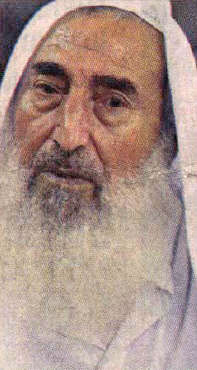
Fig. 29
Leader of Hamas assassinated by Israeli
military - 3-22-04.
Sheik Ahmed Yassin (1937-2004)
USA TODAY — March 23, 2004
JERUSALEM — Yassin, 67, was blown up, along with seven Hamas
leaders, in an Israeli missile strike.
Israel said it eliminated a man who sought to destroy it.
Hamas
has killed nearly 400 Israelis in three years. Israel warned
Palestinian authority head Yasser Arafat that he, too, could be
targeted if terrorism does not stop.
Israeli Prime Minister Ariel Sharon said after the strike that Yassin was a “mastermind of Palestinian terror, a mass murderer
who is among Israel’s greatest enemies. It is the natural right
of the Jewish nation, as it is the right of any peoples, to hunt
down those who wish to exterminate them.”
Yassin, a quadriplegic from a childhood accident, has long been
a symbol of the Palestinian uprising against Israel. He spread
his message from pulpits and in TV interviews, denouncing
Israel’s right to exist and pushing for it [the nation of
Israel] to be taken over by an Islamic state. His supporters
said he was a spiritual leader and did not take part in the
planning of attacks. Israel disagreed, saying he had a direct
role.
Yassin’s death was not expected to
disrupt Hamas’ immediate ability to carry out terrorist attacks,
and Israel was bracing for a wave of bombing attempts. The group
is tightly organized and takes its cues from leaders being
sheltered in Syria and Lebanon.
(USA Today, March 23, 2004).
Origin of the name - Assassin
Compton’s Encyclopedia, Vol.2,
p.703, 1984
“The adoption of assassination as a
political weapon derives from the Islamic world of the 11th
century. A secret order of Muslims was founded in Persia about
1090 by a man named Hasan ibn al-Sabbah. After gaining control
of a mountain fortress near the Caspian Sea, Hasan founded a
sect to fight his political enemies by means of murder. For two
centuries this secret organization terrorized the Middle East.”
“Hasan, who gained the nickname ‘Old Man of the Mountain’ from
his fortress hideaway, is said to have given his followers a
vision-inducing drug called hashish, made from Indian Hemp. The
visions of Islamic Paradise (or Heaven) brought on by the drug
persuaded his disciples they would have a glorious afterlife if
they followed Hasan’s orders and killed his enemies. The killers
were called Hashishins, from hashish. This name was eventually
corrupted into its present form,
Assassins.
“The Hashishins were a threat to the stability of the Middle
East until 1256, when the Mongol khan Hulagu stormed their
fortress and massacred 12,000 of them. A branch of their
organization in Syria was destroyed by the Egyptian sultan
Baybars a few years later.
“From then on, the sect of Hashishins became little more than
another Muslim faction, with no political influence. But
assassination did not disappear.”
Assassination as a means to a political
end continues in Islam today, including the use of mind-altering
drugs to induce the euphoric “hope” of Paradise following the act. A
modern “hope” has been added: “Awaiting you in Paradise are 72
virgins.”
In the hopeless squalor in which the modern “hashishin”
recruits live, death appears to be better than life.

Fig. 30
In the 1979 photo below, the Ayatollah
Khomeini had just arrived in Tehran, Iran
after having been flown from Paris in an
Air France 747.
“Terrorism” is not modern, nor does it
apply only to the Muslims.
The word was coined in 1795 in France
following French Freemasonry’s 1793 "Reign of Terror.” During nine
months 8 million French men and women were either beheaded, thrown
over cliffs, or drowned. In 1795, to protect the terrorists from
like death, France passed a law which to this day permits their
government to harbor terrorists, whom they call “political
activists.”
In the 1979 photo above, Khomeini has just arrived in
Iran from France, where he had met in lodge with Grand Orient Masons
to negotiate the supply of funds following the collapse of the
pro-Western regime of the Shah of Iran. Khomeini was to replace the
Shah with fundamentalist rule of the Muslim Brotherhood, Islam’s
counterpart to France’s terrorist Freemasonry. (Whole story in
Scarlet and the Beast, Vol. 3, chapter 6 “A
Freemasonry of Terrorists.”)
Following is an excerpt:
Beginning in the mid-1970s and
continuing through the mid1980s, the assassinations of European
politicians, judges, and bankers by so-called terrorists, the
mysterious death of one pope, and the attempted assassination of
another put Europeans in a quandary. It was not surprising to
learn that the ‘terrorists’ were traced to organized crime. The
links between the terrorist Red Brigades and the Mafia are
well-documented.
What was shocking to hear was that European
“terrorists” did not take orders from the Mafia, but from
a
Masonic Lodge called Propaganda Duo, or P-2 Freemasonry. P-2 was
heavily involved in a multi-billion dollar drugs-for-weapons
deal with the Ayatollah Khomeini’s Iran
(Yallop, In God’s Name, 1984).
When and How will this Conflict end?
Rev. 16, beginning with verse 12, gives the answer, which is
prophesied to take place at the end of the seven-year Tribulation:
“And the sixth angel poured out his
vial upon the great river Euphrates [Iraq]; and the water
thereof was dried up [Strong’s, Gr. #3584, ‘through the idea of
scorching’], that the way of the kings of the east [possibly
Arab nations] might be prepared. And I saw three unclean spirits
like frogs come out of the mouth of the dragon..., the beast,
and..., the false prophet. For they are the spirits of devils,
working miracles, which go forth unto the kings of the earth and
of the whole world, to gather them to the battle of that great
day of God Almighty... And he (the Lord Jesus Christ) gathered
them [the Kings of the east] together into a place called in the
Hebrew tongue Armageddon.
And the seventh angel poured out his
vial into the air; and there came a great voice out of the
temple of heaven, from the throne, saying, ‘It is done.’ And
there were voices and thunders, and lightnings; and there was a
great earthquake, such as was not since men were upon the earth,
so mighty an earthquake, and so great. And the great city
[Jerusalem] was divided into three parts, and the cities of the
nations fell; and great Babylon [Iraq] came in remembrance
before God, to give unto her the cup of the wine of the
fierceness of his wrath.
“And every island fled away, and the mountains were not found.
And there fell upon men a great hail out of heaven, every [hail]
stone about the weight of a talent [100 pounds]: and men
blasphemed God because of the plague of the hail; for the plague
thereof was exceeding great.”
MAP OF ARMAGEDDON TERRITORY
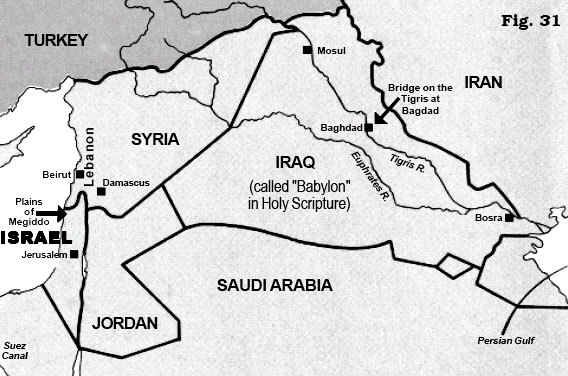
Random House Dictionary:
“Armageddon: the battlefield of Megiddo,
where the final battle will be fought between the forces of good and
evil.”
“And he gathered them together into a place called in the Hebrew
tongue Armageddon”
Plains of Megiddo are in northern
Israel, where the final battle will be fought. Holy Scripture
prophesies that the Euphrates River will dry up before the battle
begins, allowing kings of the east (Syria, Iraq, and Iran) to cross
over a do battle. Strong’s Concordance confirms that the phrase “dry
up” (Gr. #3584) carries “the idea of scorching.”
A drought strong
enough to “scorch” the Euphrates would also “scorch” the Tigris.
Scripture is specific to the Euphrates "scorching," thus isolating
the location.”
A bridge crosses the Tigris at Baghdad where Iran’s army would have
passage into Iraq. The Euphrates has no bridge, but does have a dam.
For armies to cross the Euphrates, the dam’s spillway must be cut
off. After the runoff deep mud would remain on the river bottom.
Iran could drop a nuclear bomb on any portion of the muddy riverbed,
which would instantly “dry up through the idea of scorching,”
allowing kings of the east to cross over (Rev. 16:12).
Fear of
nuclear radiation would have no affect on suicidal Moslems.
Passive Jordan and Saudi Arabia would most likely remain neutral,
forcing Syria, Iraq, and Iran to conquer Israel from the north,
which are the Plains of Megiddo. Such a war against Israel would
activate treaties with western nations, ending in nuclear world war
— the affects of which are prophesied in Holy Scripture.
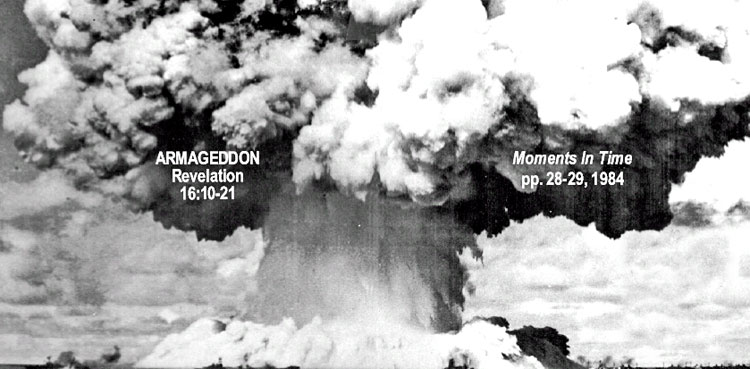
Fig. 32
Bikini Islands atomic blast caused 100
pound chunks of ice to fall to Earth
The Bikini atoll, a ring of 27 small islands around a lagoon in the
Pacific,
was the site of an atomic bomb experiment by US Military
following WW II.
70 decommissioned U.S. Ships were strategically
placed to assess damage.
Ships you see on the horizon had huge dents
in them. It was determined the dents
were caused by ocean water forced into the upper atmosphere by the
explosion, quick-freezing into chunks of ice,
then falling back to
earth.
Each chunk of ice was estimated to have
weighed at least 100 pounds.
|




















 33º
Khedive Ismail Pasha
(1830-1895)
33º
Khedive Ismail Pasha
(1830-1895) 





















